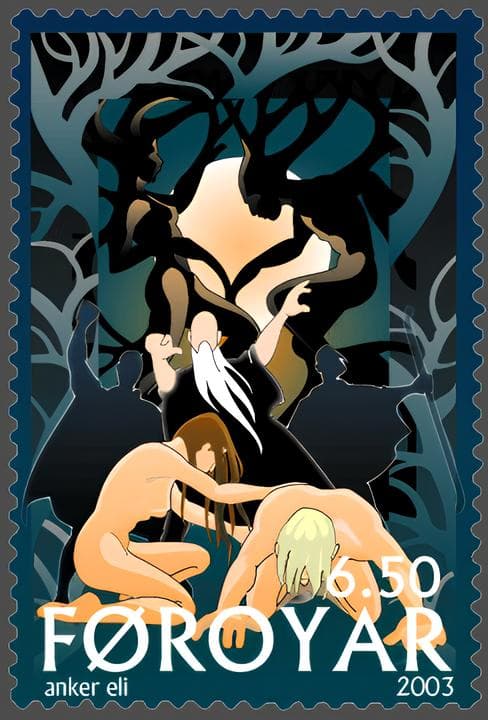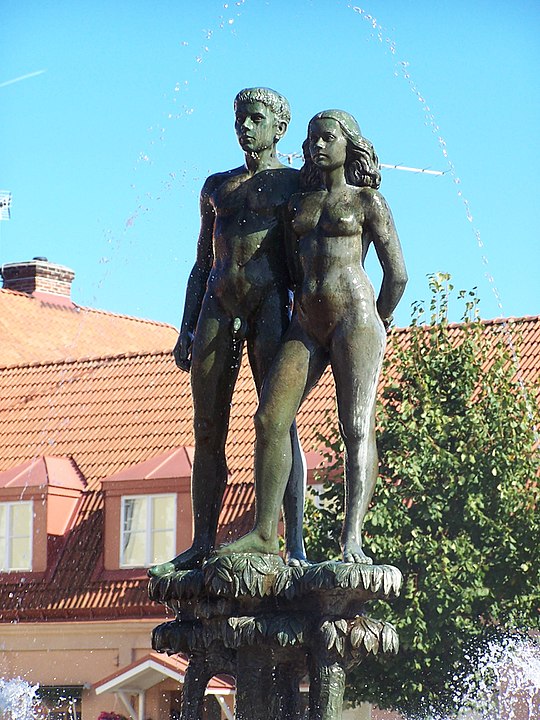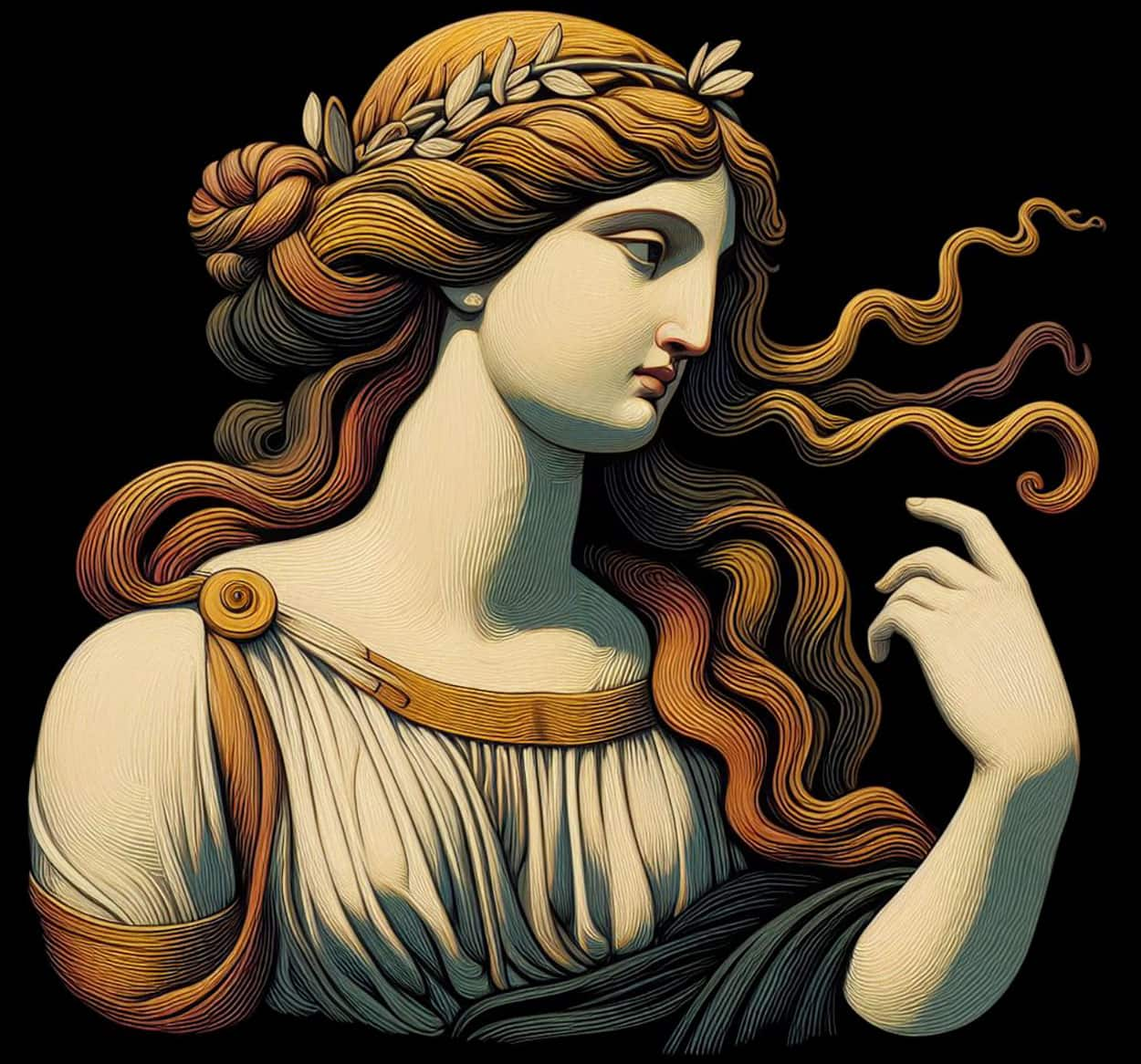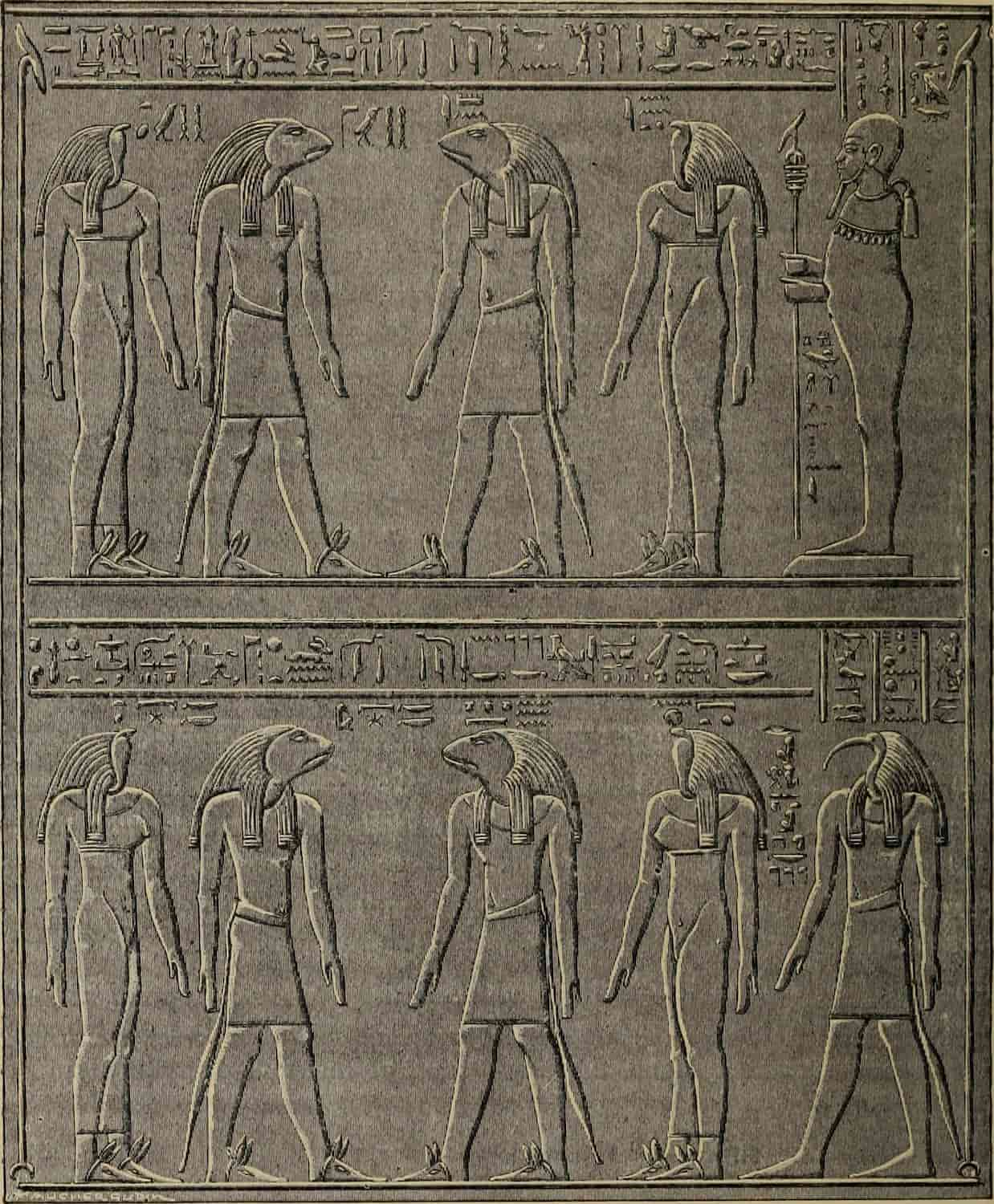In Norse mythology, Ask and Embla stand as the inaugural human beings, shaped by the divine hands of Odin, Vili, and Vé from two pieces of wood. As the forebears of all humanity and the inhabitants of Midgard—the realm of mortals—their tale intertwines with the Norse creation myth.
Ask and Embla: Mythological Origins
The Poetic Edda is a collection of Old Norse poems that preserve the ancient oral traditions of the Norse people. One of these poems, called Völuspá, tells the story of the creation of the world and the beings that inhabit it from the perspective of a seeress who reveals the past, present, and future to Odin. In this poem, the seeress says that three gods, Odin, Hoenir, and Lodurr, found Ask and Embla on the shore, without life, breath, or fate. The gods gave them these gifts, along with blood, movement, speech, hearing, and sight. The names Ask and Embla mean ‘ash’ and ‘elm’, respectively, suggesting that they were made from these types of wood.
Then from the throng | did three come forth, From the home of the gods, | the mighty and gracious; Two without fate | on the land they found, Ask and Embla, | empty of might. Soul they had not, | sense they had not, Heat nor motion, | nor goodly hue; Soul gave Othin, | sense gave Hönir, Heat gave Lothur | and goodly hue.Poetic Edda
The Prose Edda is a handbook (Gylfaginning) of Old Norse mythology and poetics, written by the Icelandic scholar and poet Snorri Sturluson in the 13th century. It is based on the Poetic Edda and other sources but also adds some explanations and interpretations of its own. In the Prose Edda, Snorri says that the three gods who created Ask and Embla were Odin and his brothers, Vili and Vé. They found two pieces of wood on the beach and shaped them into human forms. They gave them life, sense, and appearance, as well as clothes and names. Snorri also says that Ask and Embla were given a home within the walls of Midgard, the world of humans, which was made from the eyebrows of the giant Ymir, whose body was used to create the rest of the world. One of the nine realms that Yggdrasil, the world tree that supports the cosmos, connects to is Midgard.
Then said Gangleri: “Much indeed they had accomplished then, methinks, when earth and heaven were made, and the sun and the constellations of heaven were fixed, and division was made of days; now whence come the men that people the world?” And Hárr answered: ‘When the sons of Borr were walking along the sea-strand, they found two trees, and took up the trees and shaped men of them: the first gave them spirit and life; the second, wit and feeling; the third, form, speech, hearing, and sight. They gave them clothing and names: the male was called Askr, and the female Embla, and of them was mankind begotten, which received a dwelling-place under Midgard.
Next they made for themselves in the middle of the world a city which is called Ásgard; men call it Troy. There dwelt the gods and their kindred; and many tidings and tales of it have come to pass both on earth and aloft. There is one abode called Hlidskjálf, and when Allfather sat in the high-seat there, he looked out over the whole world and saw every man’s acts, and knew all things which he saw.
His wife was called Frigg daughter of Fjörgvinn; and of their blood is come that kindred which we call the races of the Æsir, that have peopled the Elder Ásgard, and those kingdoms which pertain to it; and that is a divine race. For this reason must he be called Allfather: because he is father of all the gods and of men, and of all that was fulfilled of him and of his might. The Earth was his daughter and his wife; on her he begot the first son, which is Ása-Thor: strength and prowess attend him, wherewith he overcometh all living things.
Missouri State
Symbolism and Meaning

Ask, the first man, represents the masculine principle of creation, action, and rationality. His name means ‘ash’, which is a type of wood that is strong, flexible, and resilient. Ash wood was used to make weapons, tools, and ships in the Norse culture. Ash is also the name of the first letter of the runic alphabet, which was used for writing, magic, and divination. Ask’s gifts from the gods include life, sense, blood, movement, and sight, which imply vitality, intelligence, courage, agility, and vision. Ask’s role in Norse mythology is to be the progenitor of the human race, along with Embla, and to live in harmony with the natural and supernatural forces of the world.
Embla, the first woman, represents the feminine principles of creation, receptivity, and emotion. Her name is uncertain, but it may mean ‘elm’, ‘vine’, or ‘busy’. In Norse culture, elm wood was used to make bows, furniture, and coffins. Elm is also associated with dreams, death, and rebirth. Vine is a type of plant that grows on trees, producing grapes and wine. Vine is also related to fertility, joy, and intoxication.
Busy is a word that describes someone who is active, diligent, and productive. Embla’s gifts from the gods include breath, speech, hearing, and appearance, which imply spirit, communication, listening, and beauty. Embla’s role in Norse mythology is to be the partner of Ask, the mother of the human race, and the source of inspiration and love.
Ask and Embla, as a couple, symbolize the union of opposites, the balance of forces, and the harmony of life. Complementary and interdependent, each brings something unique and valuable to the relationship. Moreover, they serve as the link between the gods and humans, bridging the gap between the divine and the mundane, the spiritual and the material. Representing the first and the last, the beginning and the end, they encompass the alpha and omega of human existence.
Connection to Human Existence
Ask and Embla’s story raises some fundamental questions about human existence, such as: Where do we come from? What are we made of? What is our destiny? How do we live in this world? According to Norse mythology, the gods created humans out of natural elements but also endowed them with divine attributes like life, sense, and breath. Humans are part of the cosmic order, but they also have free will and choice. Humans have a predetermined fate, but they also have the power to shape their own destiny. Humans live in a world that is full of wonders and dangers, but they also have the courage and wisdom to face them.
Ask and Embla’s story also reflects the Norse worldview and values, which are influenced by their environment, culture, and history. The Norse people lived in a harsh and unpredictable climate, where they had to adapt and survive. They also faced constant threats from enemies, both human and supernatural. They valued strength, honor, loyalty, and bravery, but also generosity, hospitality, and justice.
They believed in a complex and dynamic cosmology where the gods, the giants, the elves, the dwarves, and the humans coexisted and interacted. They also believed in a cyclical and tragic view of history, where the world was doomed to end in a cataclysmic battle, called Ragnarök, but also to be reborn in a new and better form.
Comparative Mythology

Ask and Embla’s story has some similarities and differences with other creation myths from around the world. For instance, in the biblical account of Genesis, God created Adam and Eve, the first human couple, from the dust of the ground and a rib of Adam, respectively.
He also gives them life, sense, and breath and places them in the Garden of Eden, where they have everything they need except the knowledge of good and evil. However, the serpent tempts them to eat from the forbidden tree, which leads to their expulsion from paradise and a curse of mortality, suffering, and labor.
Another example is the ancient Egyptian myth of Atum, the creator god, who emerges from the primordial waters of Nun and creates himself by masturbating. He then spits out Shu, the god of air, and Tefnut, the goddess of moisture, who are his first children. They produce Geb, the god of earth, and Nut, the goddess of the sky, who are the parents of Osiris, Isis, Seth, and Nephthys, the first human-like gods.
Osiris and Isis are the first divine couple to rule over the land of Egypt and teach humans the arts of civilization. However, they are also the victims of Seth’s jealousy and violence, which leads to Osiris’ death and resurrection and the birth of Horus, the god of kingship.
These examples show that Ask and Embla’s story shares some common themes and motifs with other creation myths, such as the divine origin of humans, the gifts of the gods, the role of the first couple, and the conflict between good and evil. However, it also has some unique features and variations, such as the use of wood as the material of creation, the absence of a paradise or a fall, the importance of fate and freedom, and the presence of a world tree and a world serpent.
These differences may reflect the different cultural and historical contexts of the Norse people, as well as their interactions and exchanges with other peoples and traditions.
Featured Image: Malevus.com






